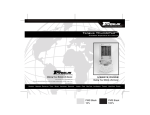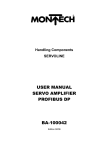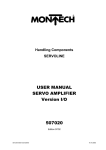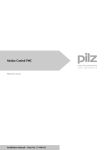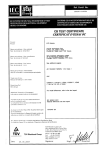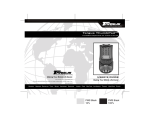Download Reference Designs for 868 / 900 and 315 MHz bands
Transcript
APPLICATION NOTE 106 EnOcean devices with Helical Antenna Reference Designs for 868 / 900 and 315 MHz bands The purpose of this document is to give some basic knowledge as well as to provide some reference design examples for compact EnOcean end-devices using EnOcean standard helical antennas for 868, 900 and 315MHz SRD bands. This document is primarily targeted at users of the EnOcean modules TCM 3xy(U/C) and STM 3xy(U/C) according to pre-existing designs from the user manuals. In principal, the reference designs can also be adapted for other modules and specific applications. Helical antennas are small and have good efficiency, offering a good alternative to the classical quarter wave, whip antenna. The size advantage is especially apparent at low frequencies i.e. 315MHz where the wavelength and therefore whip length is considerably longer. The disadvantages of helical antennas compared to whip antennas are that they are more expensive and have narrower bandwidths meaning that they are less tolerant to near field “mismatch”. Typically, a matching network is designed for a specific application which provides a good compromise between cost and performance. A helical element is a wire coil usually wound from copper, brass or steel. Compared to a monopole which is essentially a 2-dimensional structure, a normal mode working helical antenna is a 3-dimensional structure but can be considered as a “shorter monopole”. A small helical antenna significantly reduces the needed physical size of the antenna and that is important especially for longer waves (lower frequencies). However, this reduction in size comes at a price. Intrinsically, helical antennas have a higher Q factor. Bandwidth is significantly narrower and by a matter of principle, its ideal gain is lower compared to a “full size” elongated quarter wave whip. In most real cases however, helical antennas can perform as well or even better than quarter wave (physically much longer) antennas with a non-ideal (restrained) shape. Quarter wave, helical, chip or PCB antennas are, in contrast to dipole antennas, all ground dependent. That is, they must have a large ground plane to work against. A quarter wave whip and associated ground plane combine to form a complete resonant circuit (antenna) at the working frequency. The distributed capacitance of the helical quarter wave antenna acts however as an impedance matching factor that minimizes the effect of the ground plane. Since the ground plane is the other half of the antenna, its size and proximity are essential for its efficiency. Various conductive or dielectric materials in the reactive near field of the antenna (PCB, housing, underground) are unavoidable. Therefore the antenna impedance under typical application conditions (e.g. a board with housing, placed on concrete dry wall) should be measured and matched in order to reach the best real compromise. Design considerations: Ideal quarter wave, monopole whip antennas are vertically stretched on a large ground plane, with a lot of free space around them. In typical indoor applications, small housings, masonry or other things in immediate proximity strongly affect the antennas reactive near field (capacitive). E.g. producing a downwards drift of the theoretical resonance frequency. Therefore the initial antenna “unloaded” theoretical resonance frequency must be chosen slightly above the desired, “practical” working frequency of the end device, depending on the specific housing design and application environment (Distance to the antenna and the types of material). That would lead in real life to somewhat “shorter” antennas than the theoretically required quarter wave length dimension. Different materials (e.g. reinforced masonry, metal plates, dry wall or air) have different dielectric properties which affect the theoretical resonant frequency of the antenna differently. © EnOcean | www.enocean.com Subject to modifications | Christian Bach | Sep. 2015 | Page 1/ 6 APPLICATION NOTE 106 EnOcean devices with Helical Antenna Reference Designs for the 868, 900 and 315 MHz bands EnOcean small helical antennas are designed and already approved to be used without external additional matching for typical EnOcean indoor environments. The following two geometrically different reference design examples both use EnOcean helical antennas. In certain cases however, as described in this appnote, an external matching network could optimize the performance of end devices. For use with other radio devices, frequency bands or antenna types/manufacturers please respect the appropriate documentation and legal national compliance requirements. General layout considerations: The best position for a helical antenna is at the edge of PCB. The area around antenna has to be left free of metallization or any components. As a rule of thumb, the ground plane should be as large as possible without interruptions. The correct spacing of electronic components, ground plane and specific antenna near the environment is crucial for overall performance of the RF system. Two typical application examples (room controller / window contact) are given (Fig. 1 and Fig. 2). For both cases an optional (normally not used, i.e. only two 0R serial resistors mounted instead of X1 and X2) antenna matching network between the antenna foot point and the radio device is provided (more details about in Fig. 3) Fig. 1: Recommended Layout and Dimensions of two representative reference designs. Fig. 2: The manufactured PCB samples for determination of the return loss. The used PCB is a 1 mm thick, standard FR4 with 18 µm cooper layer. The 50 Ω micro-strip is realized with a 1.8 mm wide cooper path. Fig. 3 shows the equivalent circuit of an optional matching network and the corresponding layout in detail. © EnOcean | www.enocean.com Subject to modifications | Christian Bach | Sep. 2015 | Page 2/ 6 APPLICATION NOTE 106 EnOcean devices with Helical Antenna Reference Designs for the 868, 900 and 315 MHz bands Fig. 3: Equivalent circuit of the matching network and the layout. Sometimes due to specific design or application restrictions an external matching is inevitable for the required performance. In other cases, even small changes on the antenna near field could lead to severe alteration of antenna performance. Optionally provided “place holders” for serial elements X1 and X2 allow tuning of the desired resonance frequency while an optional shunt element Xgnd allows impedance matching and with it the return loss can be optimized. This provides the best matching compromise for typical use cases. Matching elements are SMD components (i.e. 0402 to 0805). The reference boards with the helical antennas were measured in the first step at 868 and 315 MHz (similarly for 900 MHz bands) and in an iterative process (step by step change of the network elements under different typical placement environments) characterized. A return loss greater than 6 dB and an acceptable bandwidth around the working frequency was realized Important: please note that while adding external matching elements in this case is not relevant with regard to the 868 MHz CE approval, for the 900/315 MHz antennas even if for itself FCC/ARIB “modular approved” any external added RF matching element would require a new FCC “device approval”. Fig. 4: Measurement of the antennas on two reference designs under different environmental conditions. It is obvious that at 315 MHz (longer wave, left) antenna bandwidth is significantly tightened while at 868 (and 900) MHz (much shorter wave, right) is wider (more tolerant to different environments). Three environmental device conditions were evaluated: (1) The PCB board without housing. (2) The PCB board with typical plastic housing on the wall. (3) The PCB board on a metallic surface. The antenna was positioned here in parallel to the metal surface with only a one centimeter gap (worst case). © EnOcean | www.enocean.com Subject to modifications | Christian Bach | Sep. 2015 | Page 3/ 6 APPLICATION NOTE 106 EnOcean devices with Helical Antenna Reference Designs for the 868, 900 and 315 MHz bands Plastic housing, walls and metallic objects effect the antenna’s near field strongly, reducing its resonance frequency. In the real world, this must also be taken in to consideration. The following table shows recommended components for the matching network, dependent on the specific application and typical environments. These values must be seen only as start and guidance values, fine tuning of the specific end device (housing, typical environment use case) to obtain the best overall compromise is recommended. The recommended approach is the typical use case “housing/wall”. Fig. 5: Used matching network component values (L & C components from Darfon: Hl1608, respectively C1005NPO series) Design verification: Due to antenna reciprocity, only transmit performance is evaluated here. The reference design boards (Fig. 6), were equipped with either TCM 300 or STM 300 modules both with identical radio settings. The modules were configured to transmit in CW mode and powered by batteries. Measurements as shown in Fig. 7 were made. Fig. 6: Realization of the four reference design boards equipped with TCM 3x0(C) Modules © EnOcean | www.enocean.com Subject to modifications | Christian Bach | Sep. 2015 | Page 4/ 6 APPLICATION NOTE 106 EnOcean devices with Helical Antenna Reference Designs for the 868, 900 and 315 MHz bands Fig. 7: Spectral transmission measurements for fast evaluation of antenna performance. IMPORTANT: Please note that a new FCC/ARIB “device approval” is required if the radio devices are used with any other than therefore specified or pre-installed, modular approved antenna listed in the corresponding user manual! EnOcean Helical Antenna Description EnOcean helical antennas are optimized to be used with EnOcean radio modules. FCC limited modular approval to be used with EnOcean radio devices is available. The antennas offer good performance within typical geometrical constrains. Cu-PHC wire delivers excellent electrical performance, omnidirectional radiation pattern, solderability and corrosion immunity at a cost effective price. Helical antenna can be attractively hidden within a plastic housing together with an EnOcean module. Two mechanically different types of helical antennas are available, one for 868 to 928MHz and another for 315MHz. Design according to the drawings below and always connect to RF_WHIP path. Please contact EnOcean to sign the mandatory limited FCC modular approval user agreement and for information regarding MOQ information. Specifications: Designed for ISM band (MHz) 315 868-928 20 35 Omnidirectional Omnidirectional Linear Linear >12 >12 Maximum Gain (dBi) -9 2 Impedance (Ω) 50 50 32(L) x 7.7(W) x 8.15(H) 23.57(L) x 6.9(W) x 7.35(H) Bandwidth (MHz) Pattern Polarization Reflection loss (dB) Dimensions © EnOcean | www.enocean.com Subject to modifications | Christian Bach | Sep. 2015 | Page 5/ 6 APPLICATION NOTE 106 EnOcean devices with Helical Antenna Reference Designs for the 868, 900 and 315 MHz bands Mechanical dimensions, Details: Helical Antenna 868 – 928 MHz Helical Antenna 315 MHz Disclaimer No liability is assumed for errors and / or omissions. We reserve the right to make changes without prior notice. For the latest documentation visit the EnOcean website at www.enocean.com © EnOcean | www.enocean.com Subject to modifications | Christian Bach | Sep. 2015 | Page 6/ 6






